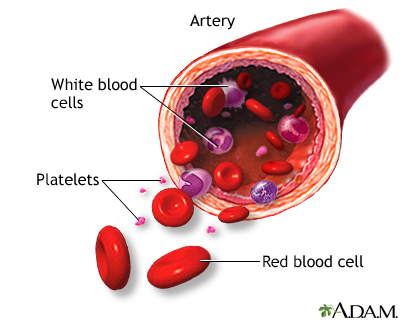Hematocrit
Definition
Hematocrit is a blood test that measures how much of a person's blood is made up of red blood cells. This measurement depends on the number of and size of the red blood cells.
Alternative Names
HCT
How the Test is Performed
A blood sample is needed.
How to Prepare for the Test
No special preparation is necessary for this test.
How the Test will Feel
When the needle is inserted to draw blood, some people feel moderate pain. Others feel only a prick or stinging. Afterward, there may be some throbbing or a slight bruise. This soon goes away.
Why the Test is Performed
The hematocrit is almost always done as part of a complete blood count (CBC).
Your health care provider may recommend this test if you have signs of or are at risk for anemia. These include having:
- Before and after major surgery
- Blood in your stools, or vomit (if you throw up)
- Chronic medical problems, such as kidney disease or certain types of arthritis
- During pregnancy
- Fatigue, poor health, or unexplained weight loss
- Headaches
- Heavy menstrual periods
- Leukemia or other problems in the bone marrow
- Monitoring during treatment for cancer
- Monitoring medicines that may cause anemia or low blood counts
- Monitoring of anemia and its cause
- Poor nutrition
- Problems concentrating
Normal Results
Normal results vary, but in general they are:
- Male: 40.7% to 50.3%
- Female: 36.1% to 44.3%
For babies, normal results are:
- Newborn: 45% to 61%
- Infant: 32% to 42%
The examples above are common measurements for results of these tests. Normal value ranges vary slightly among different laboratories. Some labs use different measurements or test different samples. Talk to your provider about the meaning of your specific test results.
What Abnormal Results Mean
Low hematocrit may be due to:
- Anemia
- Bleeding
- Bone marrow being unable to produce new red blood cells. This may be due to leukemia, other cancers, drug toxicity, radiation therapy, infection, or bone marrow disorders
- Chronic illness
- Chronic kidney disease
- Destruction of red blood cells (hemolysis)
- Leukemia
- Malnutrition
- Too little iron, folate, vitamin B12, and vitamin B6 in the diet
- Too much water in the body
High hematocrit may be due to:
- Bone marrow disease that causes abnormal increase in red blood cells (polycythemia vera)
- Congenital heart disease
- Exposure to high altitude
- Failure of the right side of the heart
- Low levels of oxygen in the blood
- Scarring or thickening of the lungs
- Too little water in the body (dehydration)
Risks
There is little risk involved with having your blood taken. Veins and arteries vary in size from one person to another and from one side of the body to the other. Obtaining a blood sample from some people may be more difficult than from others.
Other risks associated with having blood drawn are slight but may include:
- Excessive bleeding
- Fainting or feeling lightheaded
- Multiple punctures to locate veins
- Hematoma (blood buildup under the skin)
- Infection (a slight risk any time the skin is broken)
Gallery

References
Chernecky CC, Berger BJ. H. Hematocrit blood. In: Chernecky CC, Berger BJ, eds. Laboratory Tests and Diagnostic Procedures. 6th ed. St Louis, MO: Elsevier Saunders; 2013:620-621.
Kliegman RM, St. Geme JW, Blum NJ, Shah SS, Tasker RC, Wilson KM. Blood disorders. In: Kliegman RM, St. Geme JW, Blum NJ, Shah SS, Tasker RC, Wilson KM, eds. Nelson Textbook of Pediatrics. 21st ed. Philadelphia, PA: Elsevier; 2020:chap 124.
Means RT. Approach to the anemias. In: Goldman L, Schafer AI, eds. Goldman-Cecil Medicine. 26th ed. Philadelphia, PA: Elsevier; 2020:chap 149.
Vajpayee N, Graham SS, Bem S. Basic examination of blood and bone marrow. In: McPherson RA, Pincus MR, eds. Henry's Clinical Diagnosis and Management by Laboratory Methods. 24th ed. Philadelphia, PA: Elsevier; 2022:chap 31.